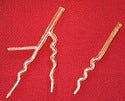October 16, 2009
Originally Published MPMN October 2009
MD&M MINNEAPOLIS 2009: FIRST-TIME EXHIBITORS
Metal Professionals Machines It All—From Gantry Tables to Anatomical Models
|
Metal Professionals fabricates silicone models of tubes, vessels, and mock arteries that are used to test the effectiveness of such medical devices as stents. |
What do gantry tables and presses have to do with models of arteries? Not much, except that for Metal Professionals (South Range, WI), both have supplied steady business over the past 13 years.
Beginning as a full-service machine shop, the company focused on custom building and machining services, designing and manufacturing machines, automation products, custom scales, gantry tables, presses, ultrasonic welders, and laser positioning tables. Then, in 2003, it started working with medical device OEMs, making prototypes and silicone anatomical models.
Despite its name, Metal Professionals works with more than just metals, notes owner Steve Schick. “We work with acrylics, plastics—just about anything that can be machined.” When it made its first foray into the medical device manufacturing realm six years ago, the company began fabricating custom jigs, fixtures, testing fixtures, and parts for catheter prototypes. Since then, it has also made miniature custom parts for devices such as tips and funnels.
The company’s specialty, however, is fabricating models of silicone arteries and vessels according to customer specifications and patient files converted from CT or MRI scans. “The silicone models can be bifurcations, straight tubing, vessels with simulated aneurysms, and parts with custom geometric shapes,” Schick explains. Components can be fabricated with custom geometric and dimensional shapes in sizes down to 0.25 mm.
“After we had begun making silicone models, we designed a flow tank to test medical devices using those models,” Schick notes. Available in different sizes, from a small portable version with a travel case to a large stationary one, the flow tanks are equipped with medical-grade introducers, a pump to simulate heartbeats, a heater, and custom-made adapters for hooking up the silicone models in the tank. “We have a customer that also hooks up real anatomy in one of our tanks,” Schick remarks.
Among other things, the models are used to test the deployment of stents. Based on actual diseased blood vessels, the company can fabricate silicone models to determine whether a particular stent will be able to repair them. For example, the company can make a silicone model of an aneurized blood vessel, place it in the flow tank, and perform tests that will show whether a given stent will eliminate the aneurism. “Silicone testing is better than human testing,” Schick comments.
In an effort to get the word out about its silicone models, Metal Professionals has set its sights on MD&M Minneapolis. “We can make any model the customer may want,” Schick says. In addition, the company can embed markers or measurement scales in its models; it can even put reinforcing strands in the silicone, if desired, and vary the thicknesses of the models. “If a customer wants a model with a thickness of 2 mm in one spot and 3 mm in another, we can accommodate that, too. We can also make dual-durometer models,” he says. The company plans on having one of its flow tanks at the show as well. “With that, we will promote our machining, designing, and building capabilities,” Schick says. “Our display will have silicone models and a flow tank that shows how it can be used for testing and deploying medical devices.”
Metal Professionals
www.metalprofessionals.net
Booth #1758
Copyright ©2009 Medical Product Manufacturing News
You May Also Like



